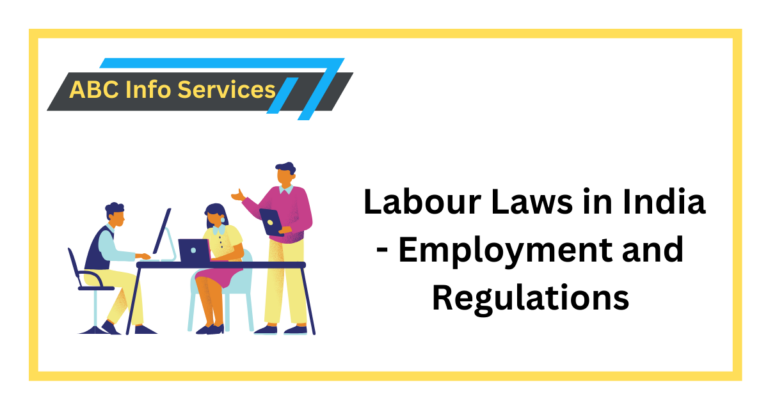In this article, we shall discuss the historic step taken by the government to simplify labour law in order to attract more foreign investment.
India has one of the largest labour forces in the world. So it is not very outlandish to learn that India has some of the most extensive and comprehensive labour laws in the world. Add to that the fact that until the late 80s and early 90s, India was following a socialist outlook when it came to framing its economic policies with importance given to upliftment of the labour classes. Businesses were required to adhere to a whole list of labour regulations to conduct commercial operations in the country.
However, with the globalisation of the economy in the 90s, a lot of foreign investment started pouring into India. This is where capital and labour, two of the most powerful forces in an economy, clashed. India was opening its doors to free market economies. But because of the strict labour laws, foreign companies preferred to manufacture their goods in neighbouring countries like china, taiwan, philippines etc. where the labour laws weren’t very stringent and labour could be hired for cheap. The goods manufactured in these countries were then imported into India for consumption, given that India is one of the largest markets in the world. This made India an import heavy country where our imports exceeded exports considerably, causing a large deficit in the GDP, which eventually led to prolonged spells of inflation.
Over the years the government has slowly and steadily been modifying its labour laws to ease the experience of doing business and allowing companies to tap into India’s massive labour force for their production needs.
However, since 2014, the reformation in the field of labour law has seen a massive surge since 2014 with the new government adopting a policy of social reformation through economic reformation. Improving the economy and providing more jobs will automatically lead to social reform. And while there are criticisms of this approach as being simplistic and superficial, there have been massive reforms in labour laws to attract more foreign investment in the country. We will now take a look at the steps taken by the government to simplify the labour laws of the country.
Merging Labour Laws
As a first move on reforming the labour laws, the government has planned to merge 44 labour laws into 4 codes – wages, social security, industrial safety & welfare and industrial relations.
This new labour legislation aims at helping investors accelerate growth. The decision was taken during an inter-ministerial meeting chaired by Home Minister Amit Shah and attended by Finance minister Nirmala Sitharaman, Labour Minister Santosh Gangwar, Commerce and Railway Minister Piyush Goyal among others.
Labour related Laws in India
All the laws related to social security, including the Employees’ Provident Fund and Miscellaneous Provisions Act, Employees’ State Insurance Corporation Act, Maternity Benefits Act, Building and Other Construction Workers Act and the Employees’ Compensation Act will be merged to create a single social security law or code.
The government has merged several industrial safety and welfare laws such as the Factories Act, the Mines Act and the Dock Workers (Safety, Health and Welfare) Act. The government merged them into a single category on industrial safety and welfare.
Similarly, the government is likely to merge the Minimum Wages Act, the Payment of Wages Act, the Payment of Bonus Act, the Equal Remuneration Act etc.
The Labour Code on Industrial Relations will combine the Industrial Disputes Act, 1947, the Trade Unions Act, 1926, and the Industrial Employment (Standing Orders) Act, 1946.
The government is expected to place this new Labour draft bill before the Union Cabinet for approval. After which it will be introduced in the coming second-week session of the Parliament. The session will take place on June 17, 2019.
The ministry last year had taken steps for formulating four labour codes: wages, social security, industrial safety & welfare and industrial relations. This was done as per the recommendations of the second national commission on labour. Also, the government had made it clear that there would be no hire and fire policy.
OSH code: 2nd Major Labour Reform
The Union Cabinet endorsed the Occupational, Safety, Health and Working Conditions Code, also known as the OSH Code, which seeks to combine 13 core labour laws into a single code that will apply to all establishments employing 10 or more employees.
The OSH Code is the government’s second major labour-reform. In comparison to the current Minimum Wages Act and the Payment of Wages Act, which applies only to workers working in those types of employment, it cleared the Wage Code, which contained “minimum wage requirements and wage compensation to cover workers in both the organised and unorganised sectors.”
The labour laws of India are complex and confusing, and the aim of the government is to simplify them into four codes: wages; OSH; industrial relations; and social security. For example, the OSH Code will ensure that regulations relating to 622 sections in 13 laws are now streamlined. protected by only 134 sections, according to government officials.
Medical Care
The law mandates the employers to not only provide a healthy working atmosphere but also regular medical tests for all workers. Also, The code specifies that creches for children under the age of six should be given for women employed in mines.
It also recommends showers or bathing places for women mine workers, and locker rooms with separate ones. The code gives every employee the power to request information.
Increased Maternity Leave
This Government increased women’s maternity leave. This code will also help to increase the number of women in the workforce.
The multiplicity of labour laws has been a nightmare for employers and employees. Besides, as our economy increased and the labour force grew, the government kept adding new additional laws. It did not consider the contradictions that might come with older laws. So 2014-19 saw the repeal of over 10 laws seen as redundant. The remaining 35 or above have been rationalised into four codes.
Conclusion
These steps taken in simplifying labour laws may have made it a lot less bulky. However, it is still important for every company to understand the labour laws that form a regulatory orbit around its operations. Non compliance with labour lawsin india can lead to punitive action and can also result in judicial trouble, leading to unnecessary expenditure and waste of time and resources. So it is always advisable to consult every once in a while with a labour law expert to guide you through the nuances of the labour law and how to tackle labour related problems. If you have any other doubts or are seeking more information on labour law or any other regulatory matter, contact our team of legal experts and they will be happy to assist you with your requirements.
Read more,










